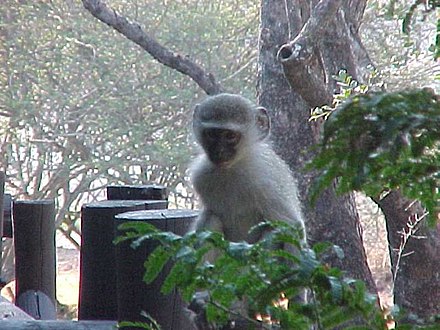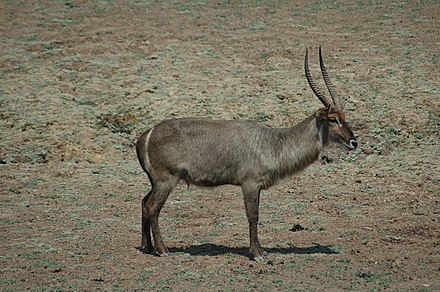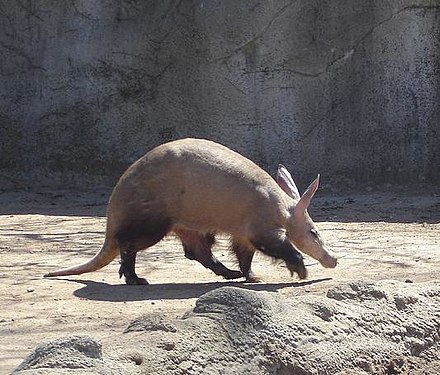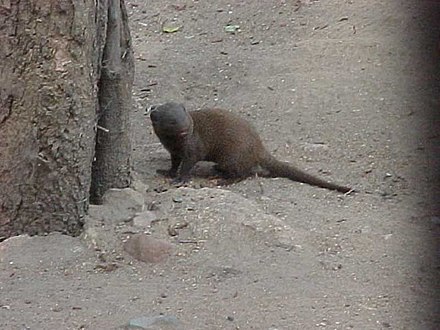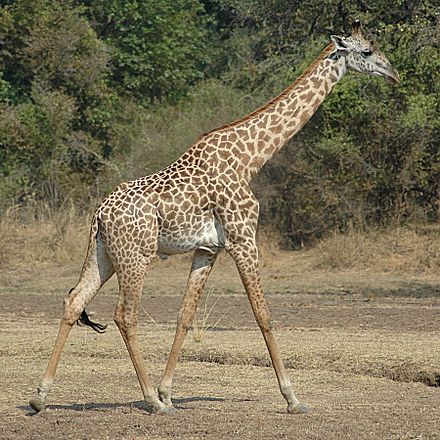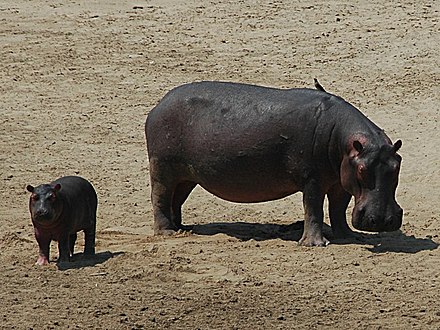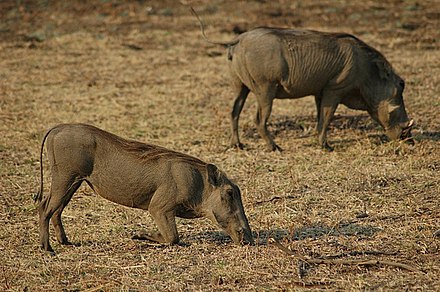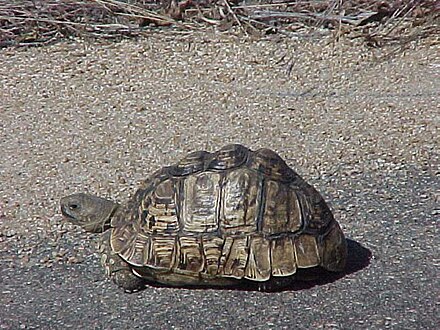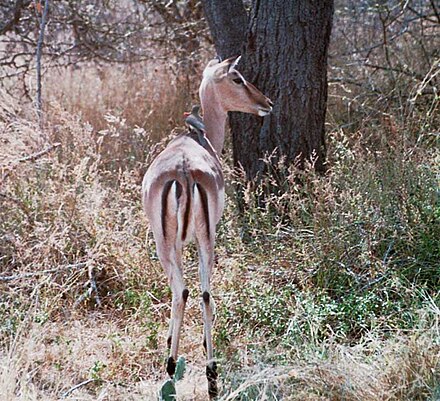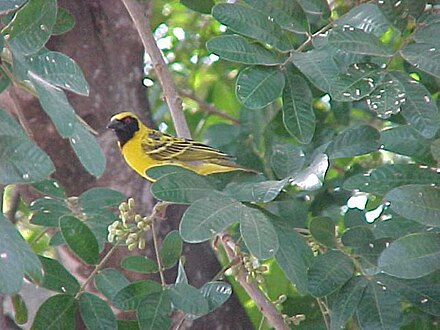African wildlife
African wildlife
African flora and fauna is a highlight of trips to Africa, especially on visits to the continent's national parks. Going on a safari is a common way to see it.
Most of Africa is part of the Afrotropical realm, together with the southern Arabian peninsula and a small part of Iran. North Africa is part of the Palearctic realm, and contains Eurasian wildlife. The wildlife of Madagascar differs a lot from the mainland, and is described in a separate article.
Many safari visitors are keen on seeing the Big Five — buffalo, elephant, leopard, lion and rhino — but there is a lot more out there if you know where to look.
Mammals
Primates
Africa is home to an extremely wide variety of primates, including all the extant great apes except the orangutan. Modern humans are also believed by most scientists to trace their origins to Africa.
Baboon
Papio ursinus, also known as the common baboon, lives in social groups guided by a dominant male. Newborn baboons are black and are carried around by their mothers. Later, they ride on the back of their mother and after three to four months they change color to the adult brown-grey.
Gorilla
Gorillas are divided into two species: eastern (Gorilla beringei) and western (Gorilla gorilla). Both are endangered, and both are only found (in the wild) in poor African countries.
The most practical way of seeing gorillas in the wild is through organized tours in Rwanda or Uganda. To see western gorillas, the Republic of the Congo appears to be the best option. Outside of these organized tours/treks, not only do you have to get very lucky to see a gorilla, but you may have to deal with dangers both natural and human.
See the following overview of tour options.
Gorillas can be found in zoos throughout the world.
Vervet monkey
Cercopithecus aethiops is a social monkey that lives close to rivers and feeds on leaves, fruits and insects. Family groups are up to 20 members strong.
Newborn vervet monkeys are dependent on their mothers for three months, and from then on they become youngsters.
Carnivores
Meat-eating mammals are the kings of the bush.
Cheetah
Cheetahs (Acinonyx jubatus) are the fastest hunters in Africa, but you are quite lucky if you can see them very close because they tend to be hidden in the high grass. You don't see them in the dense thickets of South Africa whereas the savanna in Kenya and Tanzania allows for better viewing. Cheetahs usually travel alone or in small groups consisting of the mother and her offspring. They hunt in the cool hours of the day. Cheetahs reach a maximum speed of up to 100 km/h in a short and explosive burst, and tackle their prey in a single attack. The preferred prey is Impala, but birds are on the lunch menu as well.
Leopard
Panthera pardus are famously elusive hunters that stalk their prey at night. For most visitors, the only chance of spotting one is on night drives, and Zambia's South Luangwa National Park (which allows night driving) is claimed by some to have the highest density of leopards in all of Africa.
Lion
Panthera leo are common in the wider part of Africa and can be best seen in Lake Nakuru, Masai Mara, Serengeti and to a lesser extent in South Africa, nevertheless you have to be lucky to see them very close. Lions hunt early in the morning or in the night and during the day they allow themselves to be lazy. To see them in action you have to get up before the crack of dawn or you see them only resting after a big dinner.
Their menu consists mainly of bigger mammals and zebras seem to be the favourite if available. Males often do not contribute to the hunting but they demand the "lion's" share, as they are responsible for defending the pride's territory, and female youngsters have to wait until it is their turn.
Lion cubs are dependent on their mothers for up to two years, and they start to hunt when they are about 11 months old. Lions are social cats, living in prides of 3-30 lions consisting of 1-4 males and several females.
Spotted hyena

They live in packs of 3-4 animals and can form larger groups as well. The leader of the pack is a female and they hunt often during the night but can be spotted during the daytime as well. They prey on insects, mammals such as zebras and wildebeest and sometimes they bring down a giraffe, or fight off lions from their catch. They tend to explore bins in national parks.
Cubs are dependent on their mum's milk for 9-12 months and start to look after themselves within 15 months.
African wild dog
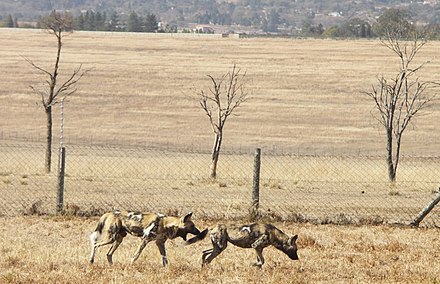 Lycaon pictus live in packs of 10-15 members.
Wild dog sightings are always a big event, so watch out for them because they are considered to be the rarest predator in Africa. Wild dogs are mainly active during the day and they hunt in the early hours or late afternoon. They prey on small mammals, Impalas, Springbok and occasionally buffaloes as well.
Lycaon pictus live in packs of 10-15 members.
Wild dog sightings are always a big event, so watch out for them because they are considered to be the rarest predator in Africa. Wild dogs are mainly active during the day and they hunt in the early hours or late afternoon. They prey on small mammals, Impalas, Springbok and occasionally buffaloes as well.
The packs have hierarchical structures where only the dominant female has pups and the rest help to care for them.
The pups are born in a den and they stay there for up to three weeks before they explore their environment. After five weeks the pups start to eat regurgitated meat. After 8-10 weeks they leave the den forever and follow the pack until they are about a year old. At that point, young females will leave their birth packs for new ones, while males will remain in their birth pack for life.
Unlike other members of the dog family, African wild dogs either do not have the copulatory tie during mating, or have a very short one.
Black Backed Jackal
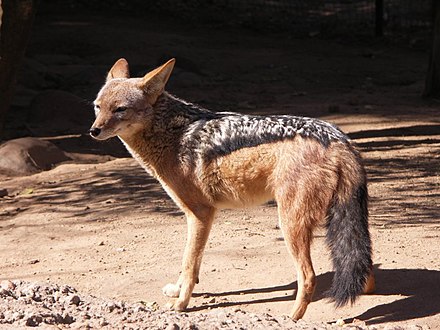 Canis mesomelas can be found throughout Southern Africa.
Canis mesomelas can be found throughout Southern Africa.
Caracal

Caracal caracal
Antelopes
Antelopes are among the most common animals seen on safari, but there are numerous species that, to the untrained eye, can be difficult to distinguish.
Bontebok
 Damaliscus pygargus pygargus are mainly found in the Western Cape of South Africa. They have white, light and dark brownish markings and are easily recognised. They live in herds. However, males leave the herd at a certain age and form in small groups of their own.
Damaliscus pygargus pygargus are mainly found in the Western Cape of South Africa. They have white, light and dark brownish markings and are easily recognised. They live in herds. However, males leave the herd at a certain age and form in small groups of their own.
Blesbuck
 Damaliscus pygargus phillipsi, closely related to the Bontebok, Blesbuck are mainly found on the highveld region of South Africa.
Damaliscus pygargus phillipsi, closely related to the Bontebok, Blesbuck are mainly found on the highveld region of South Africa.
Blue Duiker

Cephalophus monticola is a small (under 40cm shoulder height) antelope found in forested areas throughout Southern and Central Africa
Blue wildebeest
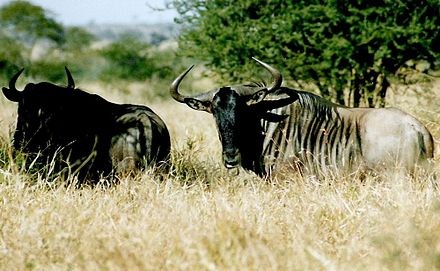
Blue wildebeest (Connochaetes taurinus) are large antelopes that form small groups and are seasonal breeders. Offspring arrive from November to February, and are born within the herd. Calves may be defended fiercely against any attacker.
Eland
Two species of antelope are known as "eland". They are the world's two largest species of antelope.
The common eland (Taurotragus oryx) can be found in open and semi-open areas throughout East and Southern Africa, though not dense forests. Males average around 1.6 m (5 ft) at the shoulder and over 500 kg (1,100 lb), though can be nearly 1,000 kg (2,200 lb). Females are roughly 25–35% smaller than males. Both sexes have fairly straight horns that spiral around the axis of growth. They are not considered endangered, and have a relatively calm disposition; some have been successfully domesticated.
The giant eland (Taurotragus derbianus) is the largest antelope; while it overlaps greatly in size with the common eland, it averages about 5–10% larger. Like its cousin, it lives mostly in open and semi-open areas, but can also live in dense forests. The horns in both sexes are similar in shape to those of common eland. The giant eland is harder to observe than the common eland, being more alert and wary. Two subspecies exist—the western giant eland (T. d. derbianus), living mainly in West Africa (particularly Senegal and Mali), and the eastern giant eland (T. d. gigas), living in Central Africa between Cameroon and South Sudan. The species is considered vulnerable but not yet endangered.
Impala
Aepyceros melampus live in big herds and newborn calves join the herd after 1-2 days. They are excellent sprinters and can outrun many predators. Males have impressive horns which are mainly used for fights over females rather than as a defence weapon.
The impala can be distinguished from other antelopes by its distinctive backside, marked with white and black stripes that resemble the McDonald's logo. Impala are hunted by lions and leopards, although in reality they are hard to catch, because the whole herd will jump and run around, totally confusing the hunting animal.
Kudu

Puku
.jpg/440px-Kobus_vardonii_(male_portrait).jpg) Kobus vardonii are common in Zambia, but not common elsewhere. Usually found in small herds of about half a dozen, puku have large lyre-shaped horns, reddish-brown fur and lack the backside markings of impala and waterbucks.
Kobus vardonii are common in Zambia, but not common elsewhere. Usually found in small herds of about half a dozen, puku have large lyre-shaped horns, reddish-brown fur and lack the backside markings of impala and waterbucks.
Red Hartebeest
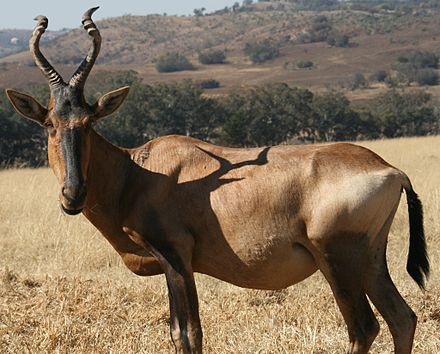 Alcelphus buselaphus can be found in Botswana, Namibia and South Africa
Alcelphus buselaphus can be found in Botswana, Namibia and South Africa
Springbok
 Antidorcas marsupialis
Antidorcas marsupialis
Often mistaken for impalas, because they look like a small impala. However their colour is different and they prefer living in the wide open fields of the arid regions of southern and southwestern Africa. They are very difficult to spot, especially in high grass.
Thomson's gazelle
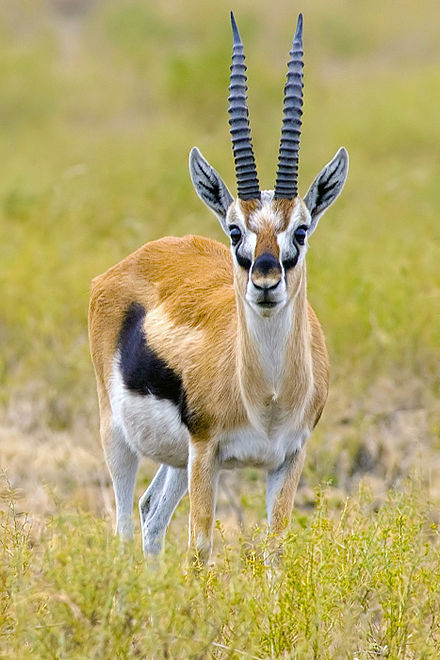 Eudorcas thomsonii
Eudorcas thomsonii
Essentially East Africa's equivalent of the springbok; the two are quite similar in size, coloration, and habitat preference. Probably the best-known of the gazelle species.
Waterbuck
Kobus ellipsiprymnus is a medium-size antelope with grey-brown fur and distinctive backside markings. There are two types: one has white ring often likened to sitting on a just-painted toilet seat, while the other has a solid white circle.
Other mammals
Aardvark
The Aardvark (Orycteropus afer, sometimes also called antbear or anteater) is a medium-sized mammal. The name comes from the Afrikaans/Dutch for earth pig ("aarde" earth, "varken" pig), because early settlers from Europe thought it resembled a pig. However, the Aardvark is not closely related to pigs.
Bat-Eared Fox

The Bat-eared Fox is named after its huge ears. Bat-eared Foxes have tawny fur, their ears, legs and parts of the face are black. They are 55 cm in length (head and body), their ears are 13 cm long. It is the only species in the genus Otocyon. The teeth of the Bat-eared Fox are much smaller than teeth of other dog species. This is an adaptation to their insectivorous diet. 80% of the diet consists of insects. Bat-eared Foxes visit termite hills, follow locust swarms or stay close to herds of zebras or antelopes in order to feed on the insects landing on their excrements. In addition to insects Bat-eared Foxes eat rodents, birds and eggs, and sometimes fruits. Bat-eared Foxes are nocturnal animals that live in small groups consisting of a couple and their young. The pairs live in dens and raise the pups (two to five) together.
Buffalo
Syncerus caffer are fierce beasts; males may reach up to 700 kg in weight. They live in herds and have a strong social bond. They can form groups of up to several thousand members when the environment permits and groups are organized by dominant males and females. Predators are actively attacked to defend calves, injured or old members. Mothers give birth to 40-kg calves which are capable of walking shortly after birth. Calves are weaned after seven months, but stay close with their mum for 12 months. Their preferred habitat is savannah with thicket or open savannah, with protective properties.
Dwarf mongoose
Helogale parvule live in social groups with one dominant breeding pair and the rest of the group assisting with raising the offspring. The mongoose is active during daytime . They run quickly into their tunnels when they are frightened but they return quickly and are amusing to watch. They are often found close to streams, rivers, ponds, as well as along open camp sites surrounded by high grass and thicket. The mongoose lives on insects, small birds and eggs.
Elephant
Most authorities now recognize two separate species of African elephant—Loxodonta africana, the African bush elephant, and Loxodonta cyclotis, the African forest elephant. The bush elephant is the largest land mammal in the world; the forest elephant is the third-largest (with the related Asian elephant falling in between). Almost all elephant viewing in Africa is of bush elephants, whose typical habitat is far more open and accessible than the forest elephant's home range in the Congo Basin.
Loxodonta africana are among the most common sightings in the Kruger National Park and you will be able to see them very close up. Amboseli in Kenya is famous for the biggest tusker in the world. For some it may be too close — it is definitely not for a fainthearted visitor.
Bush elephants are the biggest land mammals in the world. A male can weigh up to 6,000 kg and a female up to 3,500 kg. They live in large family groups led by the most experienced females. Males are only tolerated until a certain age when they have to leave the family and often form bachelor groups. Males join the female group when they are in musth but only the strongest bulls are tolerated.
Bush elephants can often be seen around rivers when they have a bath and a good sip of water. They must drink up to 160 litres of water and eat several hundred kilograms of plants per day to survive. Elephants are active at both day and night time. They are peaceful creatures and only become aggressive when they are wounded or when they feel driven to protect their young.
Giraffe
Giraffa camelopardalis are the tallest mammals on earth. Males reach a height of up to 5.2 metres and females 4.7 metres. Giraffes have a maximum mass of 1400 kg. In addition to the common giraffe, a subspecies known as Thornicraft's giraffe, with white legs and faces, inhabits Zambia's South Luangwa National Park.
Giraffes give birth after 450 days of pregnancy to a single calf of up to 100 kg and the calf can instantly stand on four legs and walks soon after. Giraffes live in loose family groups and newborn calves join the group after one week. Young giraffes grow fast and reach one meter in height within six months. Family groups can range in from 4 to up to 30 members, but the structure is loose and fluctuations are common.
Giraffes are browsers and can reach leaves that are not accessible by any other ground-based mammal. To maintain such an enormous size as a herbivore, giraffes eat for up to 20 hours a day and rest only during the hottest hours of the day.
Hippopotamus
Hippopotamus amphibius tolerate direct sunlight poorly, so during the day they are often spotted lurking in the river, little more than their nostrils visible. They come out to graze during the night. Hippo calves have a birth mass of around 30 kg and are dependent on their mothers for 5 months. After that, they start to graze.
Hippos are said to account for more deaths than any other African mammal: keep well clear of these unpredictable beasts, and ensure that they have a clear path to retreat to water.
Honey Badger

Mellivora capensis does not actually eat honey, but will raid bee hives for the larvae. These are tough little creatures that can even survive poisonous snake bites.
Meerkat
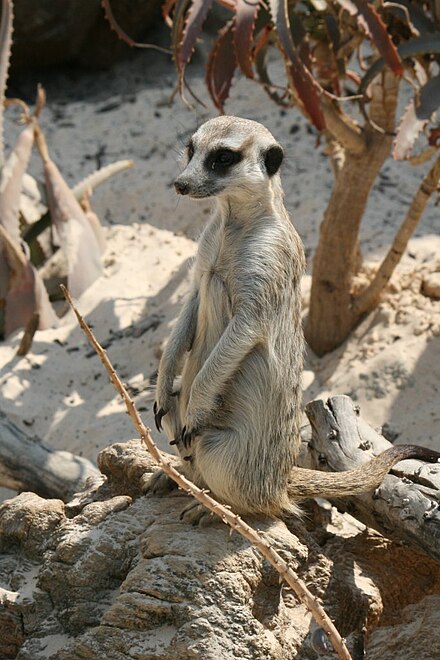
Suricata suricatta is a tiny mammal and part of the mongoose family. A group of meerkats is called a "mob" or "gang". Meerkat is a loan word from Afrikaans. The name came from Dutch but by misidentification. In Dutch meerkat (as Meerkatze in German) means guenon, a monkey of the Cercopithecus genus which possibly derives from Sanskrit markata (monkey). The traders of the Dutch East India Company were likely familiar with such animals, but the Dutch settlers attached the name to the wrong animal at the Cape. In Dutch the name for the suricate is stokstêrtje ("little stick-tail"). According to African popular belief, the meerkat is also known as the sun angel, as it protects villages from the moon devil or the werewolf which is believed to attack stray cattle or lone tribesmen. They are fascinating to watch and you could easily do so for hours. These little rascals are also the stars of the highly acclaimed Animal Planet program Meerkat Manor.
Pangolin
Pangolins have large scales on their skin and their name is derived from the Malay word pengguling ("something that rolls up"). The physical appearance of pangolins is marked by large, hardened, plate-like scales. The scales, which are soft on newborn pangolins but harden as the animal matures, are made of keratin, the same material of which human fingernails are made. It can curl up into a ball when threatened, with its overlapping scales acting as armour. The scales are razor-sharp, and provide extra defense for this reason. The front claws are so long that they are unsuited for walking, and so the animal walks in a hunched-over manner on its hind legs, balanced by its large tail. The pangolin can also emit a noxious smelling acid from glands near the anus, similar to the spray of a skunk. Pangolins have short legs, with sharp claws which they use for burrowing.
Rhinoceros
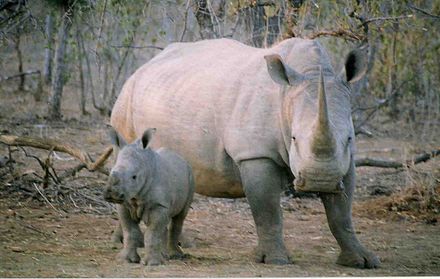
There is no difference in colour between the "Whites" and the "Blacks". The White Rhino differs from the Black Rhinoceros because of the shape of its mouth – it is wide, for cropping large swaths of grass. According to one theory, the term "White" actually comes from the Afrikaans word "weit", meaning 'wide'.
Calves can stand immediately after birth, but they are very slow at walking. After one month they can follow their mother grazing and stay close to their mother for up to three years.
Warthog
Phacochoerus aethiopicus are medium sized mammals with a mixed diet. Warthog babies are born at the beginning of the rainy season (December-January) and live for the first 6-7 weeks in their burrow and then start to follow their mothers. Note their interesting habit of bending their front legs to graze!
Zebra

The plains zebra (Equus quagga) is common in national parks throughout eastern and southern Africa and easily recognized due to its striking white and black stripes. It is divided into seven subspecies, of which six still exist (the quagga, E. q. quagga, was hunted to extinction in the late 19th century). Burchell's zebra is one of the more common subspecies, with gray "shadow" stripes, while the rarer Crawshay's zebra (found in Zambia's South Luangwa) lack these. The mountain zebra (E. zebra), a separate endangered species, is found in the dry and hilly regions of southern Africa, notably the Mountain Zebra National Park. The third and physically largest species, Grévy's zebra (E. grevyi), found only in small parts of Kenya and Ethiopia, is even more endangered than the mountain zebra and is strongly protected in both countries.
Some national parks in Kenya and Tanzania support groups of thousands of zebras. The mare leaves the herd to give birth to the foal and rejoins after birth.
Reptiles
Crocodiles
Africa has six species of crocodile. All live along rivers and are successful hunters
The Nile crocodile (Crocodylus niloticus) is the largest, most aggressive, and most widely distributed of these. It ranges throughout most of sub-Saharan Africa, and is also found along the west coast of Madagascar. They control their body temperature by lying in the sun to warm up in winter or to cool down in water in the hot summer. Modern DNA testing has found that it is more closely related to crocodilians of the Americas than to the other two African species.
The West African crocodile (C. suchus) was believed to be a subspecies of the Nile crocodile until being reclassified as a separate species in the 21st century. While not quite as large or aggressive as its Nile cousin, it is still a formidable predator. It ranges widely through Central and West Africa, and some populations even survive in the Sahel and Sahara, staying dormant in caves and burrows during the driest periods and emerging with the rains.
The West African slender-snouted crocodile (Mecistops cataphractus) is a critically endangered medium-sized crocodile found in that region. It feeds mainly on fish and small invertebrates.
The Central African slender-snouted crocodile (M. leptorhynchus) was believed to be the same species as its West African cousin until being confirmed in the 2010s as a separate species. It is also classified as critically endangered, and has much the same dietary preferences as the West African species.
The dwarf crocodile (Osteolaemus tetraspis) is either the smallest, or among the smallest, species of crocodile, with the largest specimens being barely above 1.9 m (6.2 ft) in length. It ranges through West Africa. In the 2020s, one species has already been split from it, and many scientists believe that the current population is actually two separate species.
Osborn's dwarf crocodile (O. osborni), found in the Congo Basin, was split from O. tetraspis in the 2020s. <br clear="all">
Leopard tortoise
Geochelone pardalis can be best spotted on tarred roads (they are virtually invisible in the high grass from a car). They like to drink water from tarred roads. <br clear="all">
Birds
African Black Oystercatcher
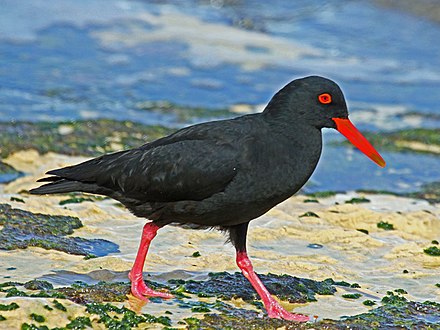 Haematopus moquini can be found along the South Africa and Namibia coastline.
<br clear="all">
Haematopus moquini can be found along the South Africa and Namibia coastline.
<br clear="all">
Blue Crane

Anthropooedes paradisea is the national bird of South Africa and also the symbol of the Zulu Royal House.
Found almost exclusively in South Africa (less than 100 still remain in Namibia), these birds are under threat with populations declining rapidly and less than 30,000 remaining in the wild.
<br clear="all">Cape Sugarbird
_2.jpg/440px-Cape_Sugarbird_(Promerops_cafer)_2.jpg) Promerops cafer can be found in the Western Cape.
<br clear="all">
Promerops cafer can be found in the Western Cape.
<br clear="all">
Carmine-chested bee-eater
.jpg/440px-Coracias_caudatus_(Crop).jpg)
Merops nubicoides is a bird that preys on insects such as bees and grasshoppers, easily recognized by its striking red chest and even more striking blue wings (only clearly visible in flight). It breeds in Zimbabwe and Transvaal, but can occasionally be seen in flocks of hundreds — a stunning sight. <br clear="all">
Crowned Plover

Darter
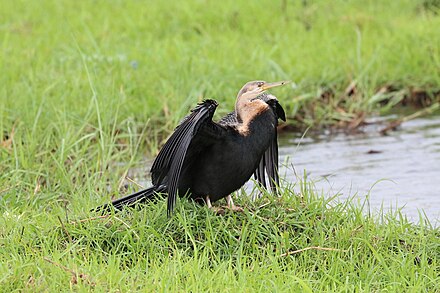 Anhinga rufa can be spotted close to dams, when drying their feathers from a previous dive.
<br clear="all">
Anhinga rufa can be spotted close to dams, when drying their feathers from a previous dive.
<br clear="all">
Fish eagle
Haliaeetus vocifer is a fish hunter and can be spotted along the Sabie river in South Africa. <br clear="all">
Ground hornbill
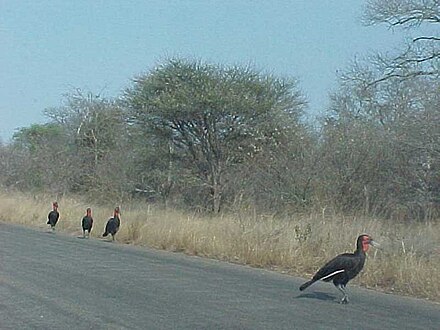 Both living species of ground hornbill—not to be confused with just "hornbill"— make their homes in Africa. These ground-dwelling birds grow up to about a metre in height and weigh about 2-6 kg when fully grown. The southern ground hornbill is slightly larger than the Abyssinian ground hornbill, and has a less distinctive horn. Their ranges don't overlap much, so you can typically tell them apart based on location. Their plumage is generally black, with either red (males) or blue (females) colour on their throats. Both species are endangered and there are citizen-science tracking projects for enthusiastic travellers to help report about them.
<br clear="all">
Both living species of ground hornbill—not to be confused with just "hornbill"— make their homes in Africa. These ground-dwelling birds grow up to about a metre in height and weigh about 2-6 kg when fully grown. The southern ground hornbill is slightly larger than the Abyssinian ground hornbill, and has a less distinctive horn. Their ranges don't overlap much, so you can typically tell them apart based on location. Their plumage is generally black, with either red (males) or blue (females) colour on their throats. Both species are endangered and there are citizen-science tracking projects for enthusiastic travellers to help report about them.
<br clear="all">
Helmeted guineafowl

Numida meleagris can be spotted often in small groups along roads when they are picking insects or seeds. <br clear="all">
Hornbill
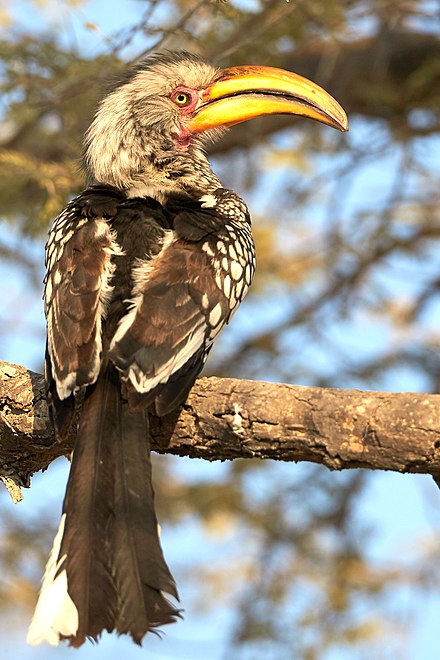 24 species of hornbill are native to Africa. Hornbills are characterised by their long, frequently brightly-coloured, bills which curve down. These monogomous birds typically feed on fruit and small animals, with varying ranges – some prefer dense forests, whilst most prefer open woodlands and savanna or even semi-desert. Most species of hornbill in Africa are medium sized birds, typically around 40-80 cm in length.
<br clear="all">
24 species of hornbill are native to Africa. Hornbills are characterised by their long, frequently brightly-coloured, bills which curve down. These monogomous birds typically feed on fruit and small animals, with varying ranges – some prefer dense forests, whilst most prefer open woodlands and savanna or even semi-desert. Most species of hornbill in Africa are medium sized birds, typically around 40-80 cm in length.
<br clear="all">
Ostrich

The two existing species of ostrich—the common ostrich (Struthio camelus) and Somali ostrich (S. molybdophanes)—are the biggest birds on earth. They can grow up to two metres. They eat grass, berries and seeds and normally live in family groups. Males are coloured white and black, while females are of a brownish colour. The two species are distinguished mainly by the color of their neck and thighs—pink for the common ostrich, and greyish-blue for the Somali ostrich. They also differ in their habitat preferences; the Somali ostrich tends to feed by browsing in more thickly vegetated areas, while the common ostrich mainly grazes on open savanna. Ostrich eggs are the largest of any animal, weighing up to 1.4 kg/3.1 lb, but interestingly are the smallest of all bird eggs relative to the size of the adult. <br clear="all">
Redbilled oxpecker
Buphagus erythrorhynchus give relief to grazing animals by removing ticks from the skin of Kudu, Impala and Steenbok. <br clear="all">
Spottedbacked weaver
This is a very colourful yellow bird with characteristic hanging nests. Breeding colonies can often be seen along rivers and birds often visit camps for some scraps of food. <br clear="all">
Saddlebilled stork
Ephippiorhynchus senegalensis is easy to spot because of its colourful appearance and its size. It spends winter in the KNP. <br clear="all">
Secretary bird
_2.jpg/440px-Secretary_bird_(Sagittarius_serpentarius)_2.jpg) <br clear="all">
<br clear="all">
Marine Life
Penguins
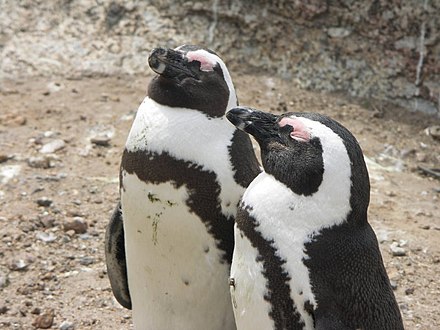 Penguins are common around the Southern African coast, especially in the colder waters of the Atlantic Ocean.
Penguins are common around the Southern African coast, especially in the colder waters of the Atlantic Ocean.
A breeding colony can be found a stone's throw away from Cape Town at Boulder Beach
<br clear="all">Whales
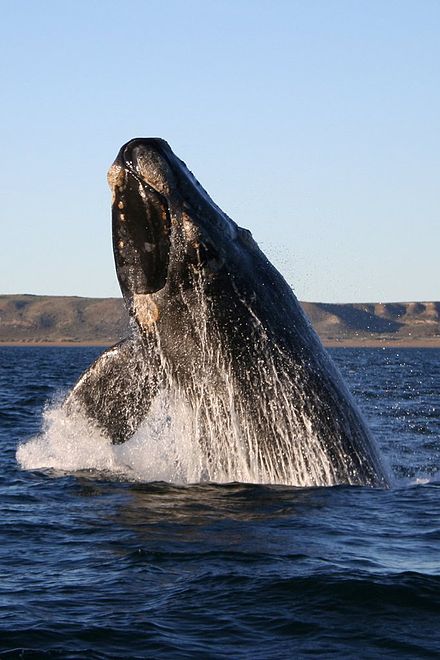 A good place for whale watching is in Cape Peninsula and Overberg, South Africa.
A good place for whale watching is in Cape Peninsula and Overberg, South Africa.
Seals
.jpg/440px-Arctocephalus_pusillus_(Cape_fur_seals).jpg) Seals can be found in many parts of Africa and often make themselves at home on the beach.
Seals can be found in many parts of Africa and often make themselves at home on the beach.
Plants
Umbrella thorn
Acacia tortillis is one of the best known trees from Africa. As its name suggests it is full of thorns and only specialist herbivores can eat its leaves without suffering from the thorn defence (see also Giraffe).
<br clear="all">Paperbark Thorn
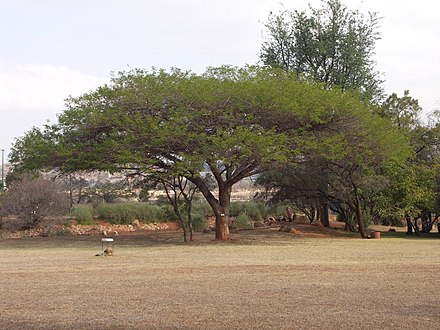 Acacia sieberiana is common throughout Southern Africa and is often the tree used to give photographs that Africa feeling since the umbrealla it forms is generally very well defined.
Acacia sieberiana is common throughout Southern Africa and is often the tree used to give photographs that Africa feeling since the umbrealla it forms is generally very well defined.
King Protea
 Protea cynaroides
Protea cynaroides
The National flower of South Africa.
<br clear="all">Aloe
 Aloe is common throughout Southern Africa.
Aloe is common throughout Southern Africa.
Weeping boer-bean
Schotia brachypetala is a tree that prefers wet ground and is commonly found on river banks and flowers only after years of good rainfall. Beautiful red flowers appear in September to October.
Welwitschia
.jpg/440px-Welwitschia_mirabilis(2).jpg)
One of the world's most unique plants, Welwitschia mirabilis is (depending on the authority) the only living member of either its family or its order. To put this into perspective, the order Artiodactyla, which includes antelope, bison, buffalo, camels, cattle, deer, giraffes, goats, goat-antelopes, hippos, pigs, and whales (not a complete list), has over 20 families and nearly 350 existing species. Welwitschia are endemic to the northern half of the Namib Desert along the coast of southern Angola and northern Namibia. After germination, two leaves develop at the edge of a woody crown. While the crown grows to no more than 1.5 m (4.9 ft) in height (as in the example pictured at right), the outside edges of the leaves split over time and can spread over a circumference as great as 8 m (26 ft). The species has separate male and female plants, with insects as the pollinators. Welwitschia are thought to be among the longest-lived plants, with some possibly being more than 2,000 years old. While not immediately threatened, it is vulnerable to overgrazing, disease, and damage from off-road vehicles. Populations in Angola are better protected because land mines laid during that country's past civil war have kept collectors away.
<br clear="all">Related: Africa
Related: African National Parks
See also
Related Wikipedia article: Fauna of Africa

